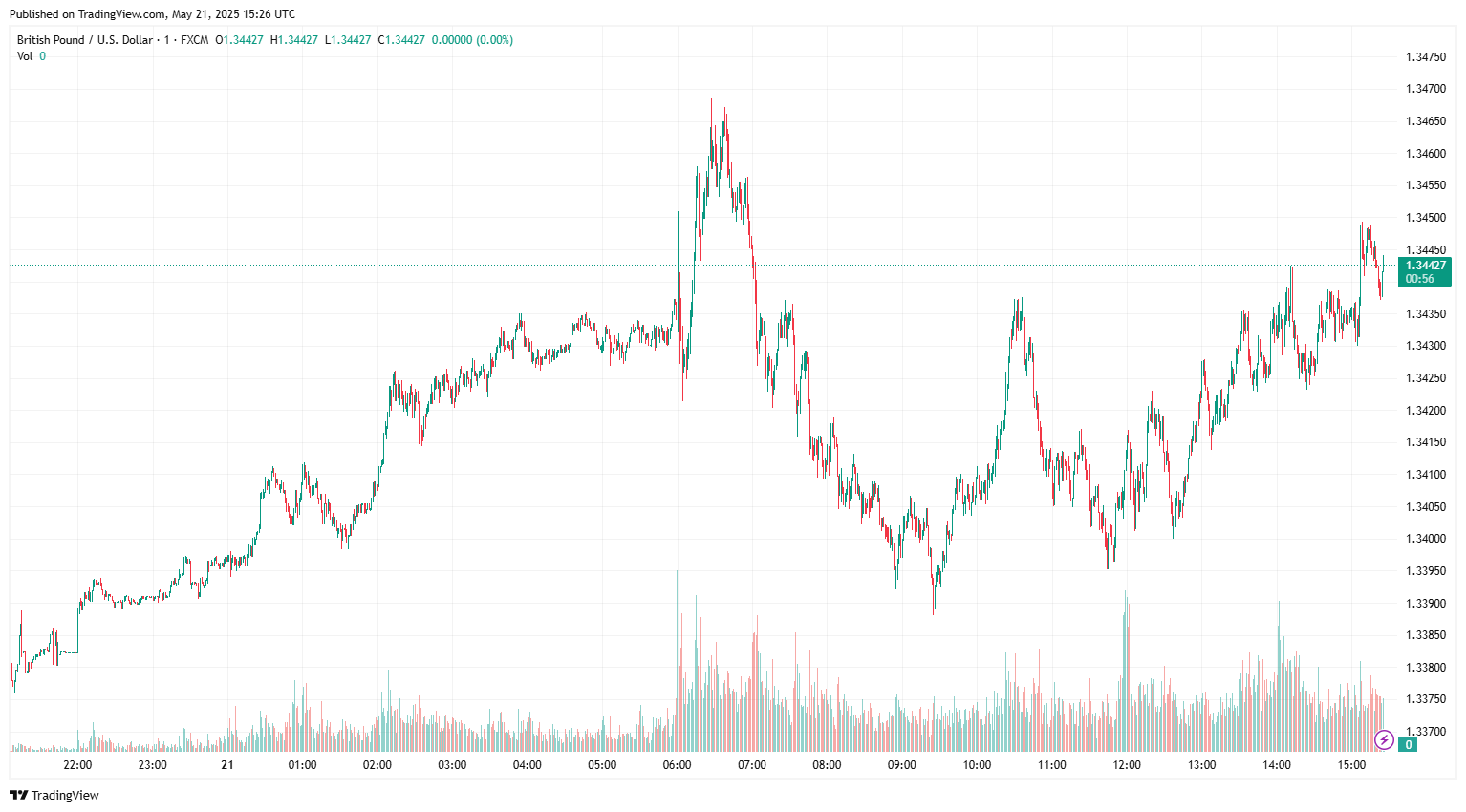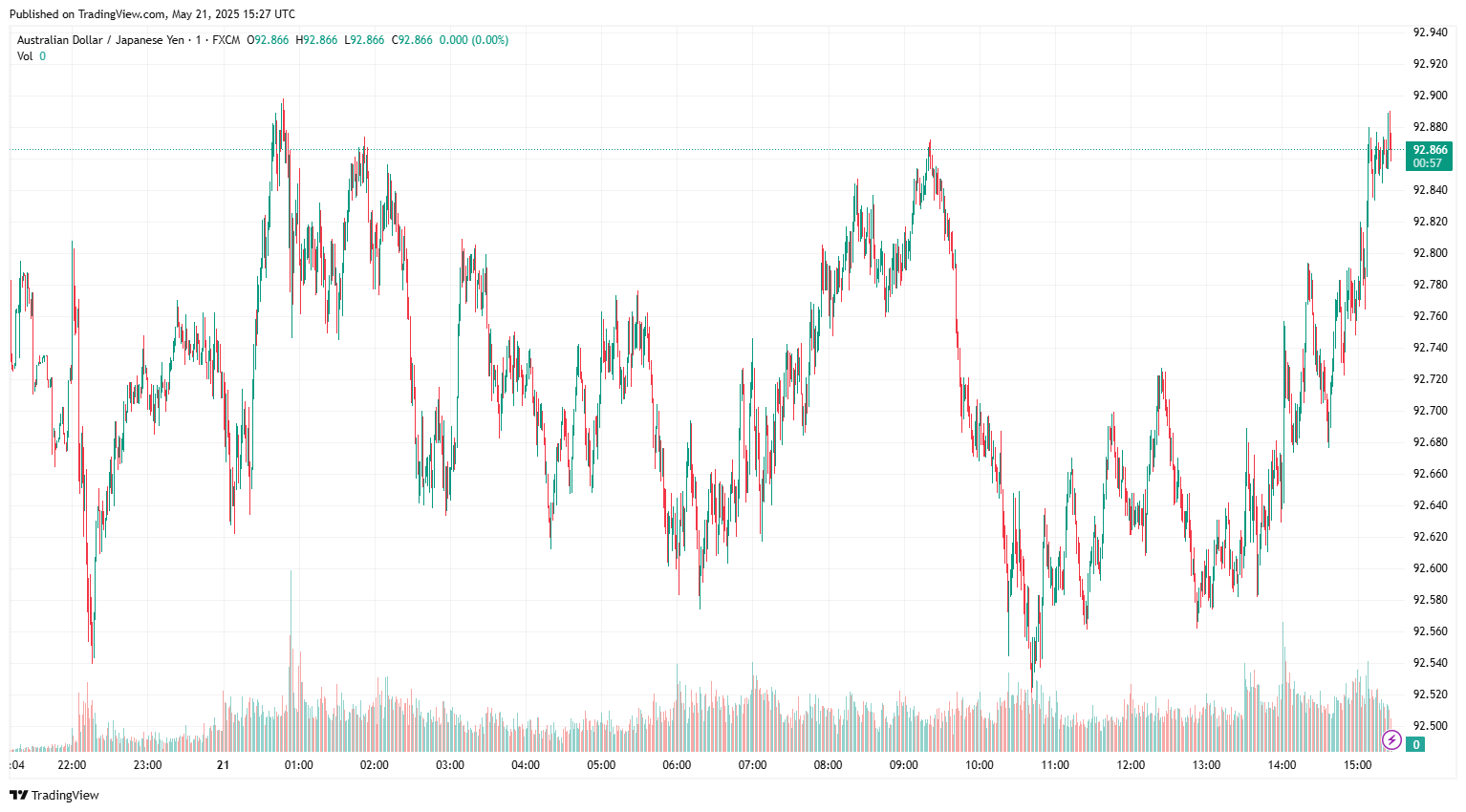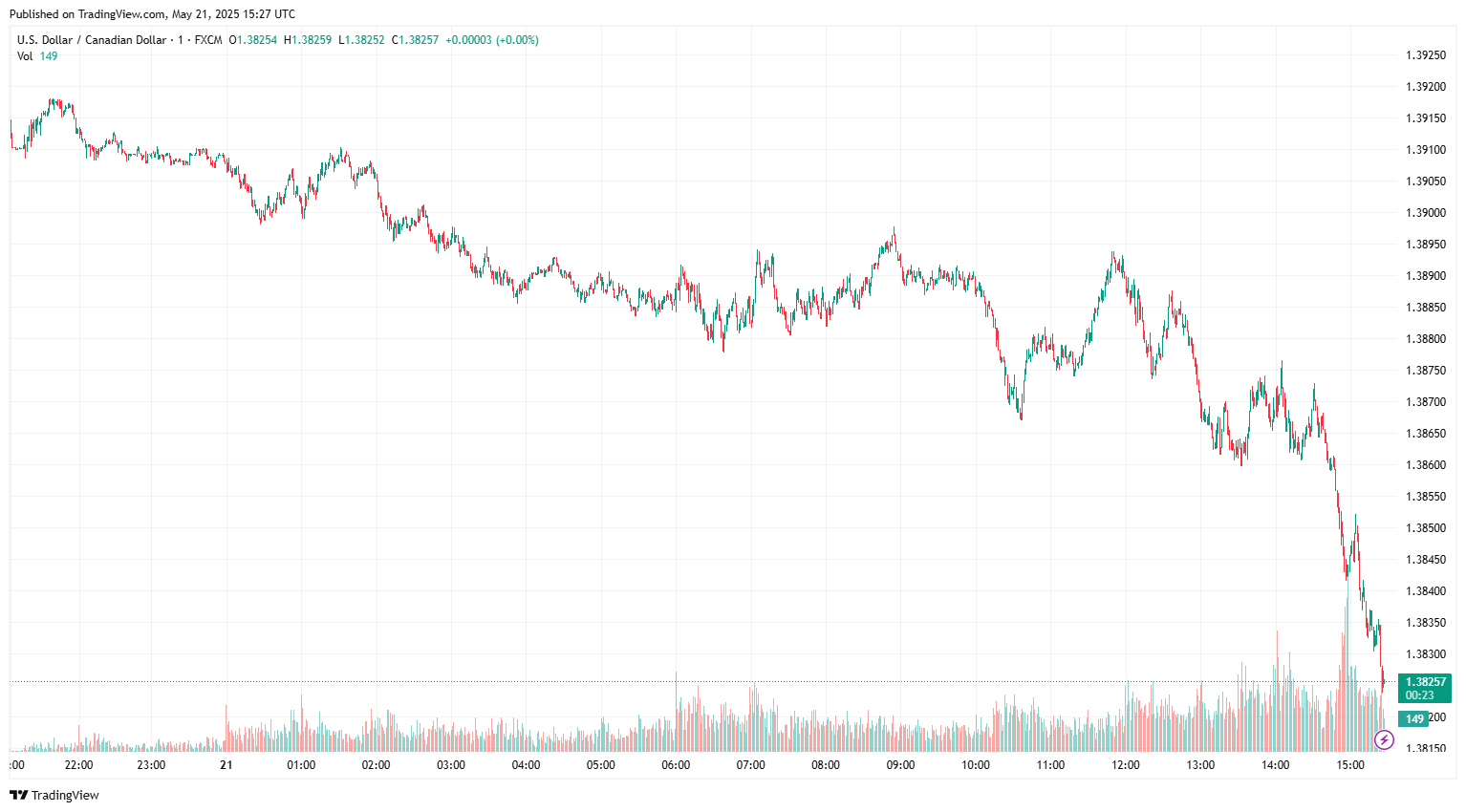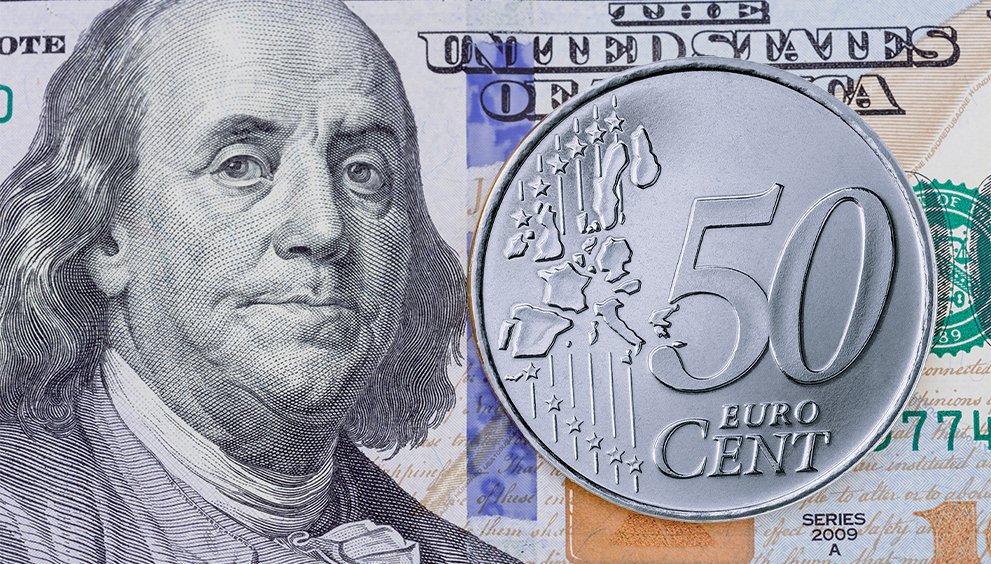GBP/USD Rebounds After Robust UK CPI Data

GBP/USD climbed to 1.3413, following the release of April’s hotter-than-expected United Kingdom (UK) Consumer Price Index (CPI) data. The annual headline Consumer Price Index (CPI) increased by 3.5% in April after recording a 2.6% growth in March, as the Office for National Statistics (ONS) data indicated on Wednesday. The market forecast anticipated a 3.3% rise for the reported period. This reading moves further from the Bank of England’s (BoE) 2% target. The core CPI (excluding volatile food and energy items) climbed 3.8% year-on-year (YoY) during the same period, compared to a 3.4% increase in March, surpassing the expected figure of 3.6%. Services inflation strengthened to 5.4% YoY in April, up from March’s 4.7%. Meanwhile, the monthly UK CPI inflation surged to 1.2% in April from 0.3% in March, while markets predicted a 1.1% reading. Rising inflationary pressures due to a notable increase in the prices of housing and household services, transportation, recreation and culture are expected to compel BoE policymakers to remove their “gradual and cautious” monetary expansion guidance from their next policy announcement, scheduled for June, and will pressure traders to pare dovish bets. On Tuesday, the BoE Chief Economist, Huw Pill, warned of caution regarding interest rate cuts due to the “potential inflationary impact of structural changes in price and wage-setting behaviour, following the experience of prolonged, well above-target inflation in recent years.”
On the other hand, the greenback continues to undermine the cautious tone adopted by Federal Reserve (Fed) officials regarding the economic outlook and business sentiment. On Friday, Moody’s downgraded the US long-term issuer and senior unsecured ratings from Aaa to Aa1 due to the growing $36 trillion US government debt burden. During an interview, Federal Reserve Bank of Cleveland President Beth Hammack emphasised that ongoing US government policies complicate economic management for policymakers. She warned that if these issues persist, there is an increasing risk of stagflation, characterised by low growth coinciding with high inflation. Echoing her concerns, Federal Reserve Bank of St. Louis President Alberto Musalem cautioned that US trade policy under the Trump administration could hinder growth and increase price volatility, a term often used by the Fed in place of inflation. He noted that if trade tensions decrease sustainably, inflation might return to target levels, the labour market could stay robust, and the current monetary policy would remain suitable. On Tuesday, Republican lawmakers opposed the new tax bill, which aims to raise deduction limits for state and local tax payments, according to Representative Mike Lawler, as per reports. Meanwhile, Democrats argued the bill would undermine social programs and favour the wealthy, reacting to the tightening of Medicaid norms in the bill.
Investors will pay attention to the Manufacturing PMI release for both the UK and the US for further insights on the GBP/USD exchange rate.

AUD/JPY Subdued Following RBA’s Dovish Interest Rate Decision
AUD/JPY lost momentum near 92.84, following the Reserve Bank of Australia’s (RBA) interest rate decision. On Tuesday, the RBA board announced a 25 basis point reduction in the Official Cash Rate (OCR), decreasing it from 4.10% to 3.85% during its May policy meeting, aligning with market expectations. The monetary policy statement from the RBA highlights that rising global trade tensions pose a notable downside risk to the economy. Additionally, the global growth forecast has been revised downward, and uncertainty has increased due to US tariff policies. In a press conference following the policy announcement, RBA Governor Michele Bullock underscored the importance of controlling inflation and expressed confidence in the RBA’s ability to achieve this goal. She described the rate cut as a proactive step taken with assurance, stating it was the appropriate response to the current economic conditions. Bullock also pointed out that the Board is prepared to implement further measures if necessary, suggesting that additional adjustments could be forthcoming. The risk-averse Australian dollar continues to decline amid growing political instability in Australia, as the opposition coalition has fragmented following the National Party’s exit from its alliance with the Liberal Party. At the same time, the ruling Labour Party has bolstered its power with a more robust mandate, taking advantage of the Opposition’s crisis. Globally, growing optimism over a 90-day US-China trade truce and expectations for new trade agreements with other nations continue to bolster the Aussie. On Tuesday, the PBoC announced a reduction in its Loan Prime Rates (LPRs). The one-year LPR decreased from 3.10% to 3.00%, while the five-year LPR dropped from 3.60% to 3.50%. In April, China’s retail sales rose by 5.1% year-over-year (YoY), falling short of the 5.5% forecast and down from 5.9% in March.
On the other hand, hawkish BoJ expectations, despite Japan’s weaker-than-expected Q1 Gross Domestic Product (GDP), and optimism regarding a potential US-Japan trade deal ahead of a third round of negotiations supported the Japanese Yen (JPY). Bank of Japan Deputy Governor Shinichi Uchida informed Parliament earlier this week that Japan’s core inflation is poised to re-accelerate after a slowdown and is expected to hover around the 2% target. Uchida also mentioned that the BoJ will proceed with raising interest rates if the economy and prices improve as projected. Additionally, the BoJ’s Summary of Opinions disclosed last week that policymakers still intend to consider further interest rate hikes. Japanese and US government officials are preparing for a third round of high-level trade talks in Washington this week. Japan’s trade minister, Ryosei Akazawa, is set to engage in ministerial-level conversations with US Trade Representative Jamieson Greer. US Treasury Secretary Scott Bessent is also expected to participate in the discussions. Reports indicate that US officials are urging Japan to reach an expedited conclusion to the talks, hinting that a deal could be reached sooner. Government data released on Wednesday showed that Japan’s trade balance unexpectedly slipped into a deficit of ¥115.8 billion in April, down from a surplus of ¥559.4 billion surplus in the previous month. Japanese imports declined at a slower-than-expected rate, as a significant rise in spring wages boosted private consumption, while export growth experienced a marked decline due to weakened US demand following President Donald Trump’s increased import tariffs.
In the upcoming sessions, renewed US-China trade tensions, persistent geopolitical risks, and forthcoming Japanese and Australian inflation numbers will influence the AUD/JPY exchange rate.

USD/CAD Sinks Amid Rising Oil Prices
USD/CAD drifts lower to 1.3882, as rising crude oil prices and reduced expectations for a June BoC rate cut support the Loonie. Crude prices climbed to a one-month high due to reports of Israel planning a strike on Iranian nuclear facilities, heightening fears of supply disruptions from the Middle East. Additionally, indications of stalled US-Iran nuclear negotiations bolster the price of crude oil, which is also expected to support the commodity-sensitive Canadian dollar. Tuesday’s hotter-than-expected Canadian core inflation figures softened the market confidence that the Bank of Canada (BoC) will reduce the interest rate in June’s policy meeting, further influencing the currency. Canada’s inflation edged lower in April, with the Consumer Price Index (CPI) increasing by 1.7% from the same month last year, down from March’s 2.3% gain and above prior estimates, Statistics Canada reported. The headline CPI decreased by 0.1%, down from the preceding month’s 0.3% increase. The core CPI monitored by the Bank of Canada (BoC), which excludes volatile components such as food and energy, has accelerated to 2.5% YoY, rising from the previous period’s 2.2%. The BoC core CPI increased sharply monthly in April, climbing to 0.5% MoM compared to March’s 0.1%.
On the other hand, the cautious tone of the Federal Reserve (Fed) officials concerning the economic outlook and business sentiment depreciates the greenback. The US Dollar Index (DXY), which measures the US Dollar (USD) against a basket of six major currencies, is experiencing losses for the third consecutive session. The recent announcement by Moody’s regarding its downgrade of the US credit rating from Aaa to Aa1 follows similar downgrades by Fitch Ratings in 2023 and Standard & Poor’s in 2011, dragging the USD lower. Moody’s also forecasts that US federal debt will rise to approximately 134% of GDP by 2035, up from 98% in 2023, with the budget deficit expected to increase to nearly 9% of GDP. On Tuesday, Raphael Bostic, President of the Federal Reserve Bank of Atlanta, warned that growing numbers of businesses are preparing to adjust their pricing and employment figures in response to US tariffs affecting the economy. As trade policies threaten to disrupt domestic consumption and production, the Fed feels compelled to observe the consequences before implementing any changes to interest rate policies. Earlier, he also commented that the Fed is on track to implement only a single quarter-point rate cut in 2025. This undermines current market expectations of at least two cuts by December, with four total rate cuts anticipated by the second half of 2026.
In the upcoming sessions, US Purchasing Managers Index (PMI) figures, speeches by influential FOMC members, and crude oil price dynamics will drive the USD/CAD exchange rate.

NZD/USD Struggles Amid Renewed US-China Tensions
NZD/USD weakened to 0.5929, due to the weaker US Dollar (USD) following the cautious remarks by the Fed policymakers. At a discussion panel organised by the Federal Reserve Bank of Atlanta, Mary C. Daly and Beth Hammack, Presidents of the San Francisco and Cleveland Fed Banks, respectively, expressed their concerns regarding the current US economy. Mary noted that while Federal Reserve policies are currently well-positioned, they remain particularly vulnerable to inflation risks. She has yet to assess the overall impact of the Trump administration’s trade, immigration, and other policies. Beth Hammack warned that the sentiment data regarding the economy is concerning, and it will take longer to see how trade policy influences business decisions.
Conversely, the Kiwi fluctuated within a narrow trading range due to increasing selling pressure following the People’s Bank of China (PBoC) decision to lower both key lending benchmarks. The one-year loan prime rate (LPR), which serves as the basis for most business and household loans, was reduced by 10 basis points to 3.0%. Simultaneously, the five-year LPR that impacts mortgage rates was cut by 10 basis points to 3.5%. This action, intended to boost domestic demand, underscored ongoing worries about China’s sluggish recovery, putting pressure on currencies closely linked to the Chinese economy, such as the New Zealand Dollar. Additionally, renewed US-China trade tensions are reviving safe-haven demand, further dampening the New Zealand dollar. On Wednesday, China’s Commerce Ministry stated that US measures on China’s advanced chips are ‘typical of unilateral bullying and protectionism.’ Chinese authorities are looking further into whether the United States is serious about correcting its erroneous practices.
On the data front, Statistics New Zealand revealed that the country’s trade surplus jumped to NZ$1,426 million in April, up from NZ$794 million previously, driven by strong dairy and fruit exports. This result exceeded the market expectation of NZ$500 million. However, despite this positive monthly outcome, there remains a significant trade deficit of NZ$4.81 billion year-on-year in April. The BusinessNZ Services Index fell to 48.5 in April 2025, down from 48.9, indicating a modest slowdown in the performance of the services sector. In Q1 2025, the Producer Price Index (PPI) Input experienced a quarter-on-quarter increase of 2.9%, rebounding from the previous quarter’s decline of -0.9%. The PPI Output also rose by 2.1% QoQ in Q1 2025, following a slight decrease of -0.1% in Q4 2024.
In today’s session, the US Manufacturing PMI, along with the Federal Reserve’s (Fed) Thomas I. Barkin’s speech will influence the market sentiment around the NZD/USD exchange rate.



 English
English 



































































































